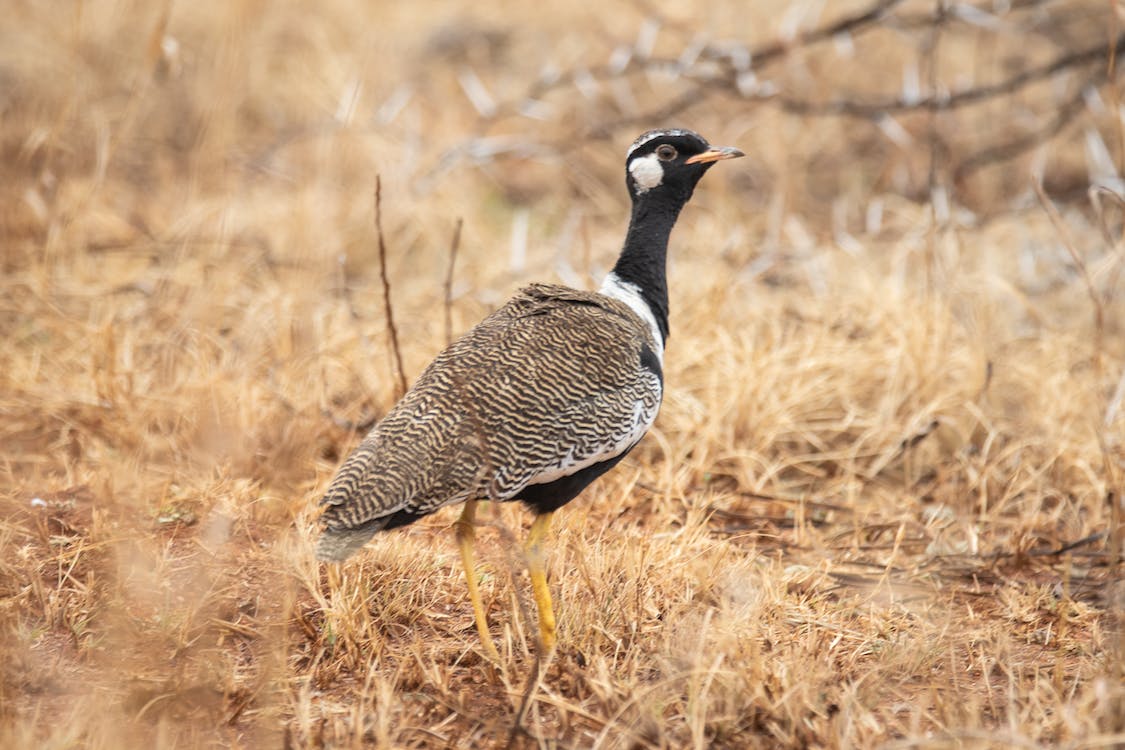The Black-Bellied Korhaan, also known as the Black-Bellied Bustard and Lissostis Melanogaster, is a ground-dwelling bird that falls in the Bustard family. The Bustard family includes bird species such as floricans and korhaans. They are large, terrestrial birds that usually frequent dry grassland regions. The Black-Bellied Korhaan’s closest relatives include Bengal Florican, Karoo Korhaan, Little Brown Bustard, Buff-Crested Bustard, and Southern Black Korhaan.
This bird species is indigenous in sub-Saharan Africa’s open grassland areas, particularly in south KwaZulu Natal, central, east, and west Africa. According to researches, the population of this bird species has plummeted in some parts of southern Africa. Numbers have also decreased in northern KwaZulu Natal and Swaziland due to loss of habitat caused by human interventions, deforestation, and commercial afforestation. Despite the reported decline of their population, the International Union for Conservation of Nature (IUCN) Red List categorized the Black-Bellied Korhaan as Least Concern.
Its seven levels of scientific classification are as follows:
Kingdom: Animalia
Phylum: Chordata
Class: Aves
Order: Otidiformes
Family: Otididae
Genus: Lissotis
Species: L. melanogaster
The physical characteristics of a Black-Bellied Korhaan
An adult Black-Bellied Korhaan can grow from 58 to 65 cm long. It has distinctive long legs and neck that allows it to observe over tall grass. It has a dull yellow bill. A male Black-Bellied Korhaan’s upperparts have brown and black marks, while the underparts are black in color. The head is buff and patterned with black and white. The long, thin neck is said to be too long for a bustard. It is brown with a narrow black line that extends to the black breast. Its tail is brown and buff with four to five dark brown bands. The wings’ upper surface is white with a brown triangle. Meanwhile, its flight feathers have dark tips except for the secondary feathers. When a Black-Bellied Korhaan stands, its white wings stand out.
A female Black-Bellied Korhaan is usually smaller and lighter in color than a male. Both sexes have markings on the back, but males have more prominent markings on their bellies, necks, and wings.
The distribution and habitat of Black-Bellied Korhaans
This bird species occurs across sub-Saharan Africa. It is uncommon in north-eastern Namibia, Zimbabwe, northern Botswana, Mozambique, and South Africa. Black-Bellied Korhaans prefer habitats like dense woodland savannahs, arid woodlands, grassy savannahs, cultivated pastures, fallow lands, fields, bushwillows, and miombo woodlands. This bird species prefers those areas near the edges of wetland areas.
The behavior of Black-Bellied Korhaans
Black-Bellied Korhaans are polygamous animals. The breeding season for this bird species occurs from October to February. The courtship display is characterized by the male, showing off an elaborate ritual to attract multiple female Black-Bellied Korhaans. The male bird will showcase a slow display fight, slowly raising its wings to appear larger than its usual size. After that, it will glide down straight to the ground, wings still outstretched, while exposing his black belly.
During this period, males exhibit heightened territorial habits as well. They will stand on an elevated spot, stretch their necks to make themselves more visible, and expose their black lines that run on the neck down to their bellies before crying a croaking call. After that, they will pull their necks and press it against their breasts before releasing a popping sound.
Black-Bellied Korhaans do not usually have nesting sites. Open grounds already make excellent nesting sites as they are. A female Black-Bellied Korhaan will lay one to two eggs between September and March. The eggs are incubated and taken good care of by the female alone. The eggs have light olive green, brown, and grey blotches, which make them well-camouflaged on open areas with tall grass. Once the eggs are hatched, the female will feed and protect the chicks alone. A protective mother will also ward off intruders such as warthogs if they get close to the chicks.
The diet of Black-Bellied Korhaans
Black-Bellied Korhaans are omnivorous birds that mainly feed on invertebrates such as grasshoppers, cockroaches, ants, and beetles—all of which are considered pests by humans. They perform a significant role in controlling the population of pests across the continent.
In addition, this bird species also feed on plant matter such as fruits, berries, seeds, palm kernels, green leaves, and flowers.
Sources:
https://en.wikipedia.org/wiki/Black-bellied_bustard
http://www.biodiversityexplorer.info/birds/otitidae/lissotis_melanogaster.htm
https://www.sabisabi.com/wildfacts/black-bellied-bustard/
https://en.wikipedia.org/wiki/Bustard
http://sabap2.birdmap.africa/docs/sabap1/238.pdf
BOTSWANA BIRDS | SOUTH AFRICA BIRDS
NAMIBIA BIRDS | ZAMBIA BIRDS | ZIMBABWE BIRDS
